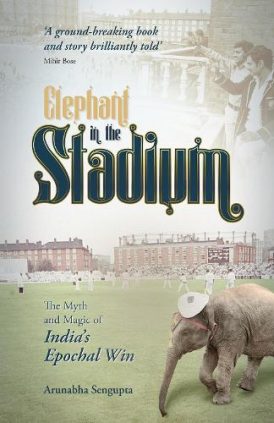Elephant in the Stadium
Martin Chandler |Published: 2022
Pages: 462
Author: Sengupta, Arunabha
Publisher: Pitch
Rating: 4.5 stars

Last year was the fiftieth anniversary of India’s twin successes in the Caribbean and England in 1971 and, not unexpectedly, two books appeared to celebrate those momentous months in cricket history. The two books adopted differing approaches to their task, but both were well worth reading. Against those events I have to say that I did wonder, on learning that this one was due to appear, whether Arunabha Sengupta could really add very much more. The answer is he most certainly can.
To the extent that Elephant in the Stadium recounts the cricket played in 1971 it does a good job. It is never a straightforward task to repackage events that have been widely written about in the past, but Sengupta manages to add an additional dimension to his account by regularly referencing the recollections of those who witnessed the events unfold. By which I mean not simply the views of surviving players, or the descriptions and reports made by members of the press at the time. Sengupta has canvassed the opinions of ‘ordinary’ spectators, whose perspective adds a valuable gloss to what has been written before.
Impressive as its cricketing content is what particularly hit home with me about Elephant in the Stadium is its confirmation that, as a child, my education was woefully incomplete. It is a feeling that has been creeping up on me ever since I left school, and has been gathering pace in recent years, but much has changed for me as a result of reading what Sengupta has now told me.
When I was at school Great Britain had a glorious history. We demonstrated to the world how nations should be run, and pioneered industrialisation and education. Having introduced much of the rest of the world to these concepts we then returned its freedom to it, whilst remaining at the centre of a supportive commonwealth of nations. At least that is the impression I took into tertiary education.
I was perhaps fortunate that very early in my university career I got to know a fellow student from Sri Lanka, and another from Trinidad. Comments they made in those politically charged arguments that budding intellectuals have whilst under the influence of alcohol, coupled with what I soon learnt as a first year law student, started my doubts. I wish now I had peered a little harder over the years at some of the things I had heard, but like many others it took the rise of the Black Lives Matter movement to really open my eyes to the realities of the past.
And there is a lot to learn, even when the subject matter of the lessons is largely restricted to Britain’s relationship with India. One thing I did know about was the Amritsar Massacre of 1919, but not the full horror of it. On the other hand the Bengal Famine of 1943 had passed me by completely, but those two incidents are just specific examples of a deeply troubling history. It is a complex one too, the relationships between the princely states and the British Government having been something I had never seriously attempted to understand before, and I certainly had no idea that there were as many as 565 of those fiefdoms.
There is also much in Elephant in the Stadium about the tensions between India and Pakistan. At the time of the 1971 tour the crisis in East Pakistan, now of course Bangladesh, was coming to a head. It was disappointing, if not altogether surprising, to learn that the root cause of much of problems was just what a mess Britain made of partition in the first place. Without that complete Horlicks being made in 1947 that dreadful conflict might, I suppose, have been avoided. Inevitably the reputations of some great Britons take a fall, and none drop further than the loftiest of them all, that of Sir Winston Churchill.
The best indicator of the breadth of an author’s research is gained by looking at a book’s bibliography. Most cricket books, and this is no surprise nor, necessarily, a complaint, in the main reference other cricket titles. Sengupta too read many cricket books in the course of his research, but in the nine pages that his list of sources takes up he also references many books that deal with many other subjects, none of which I have ever read.
The history lesson taught by Elephant in the Stadium could not be more important, but despite that it is a pleasure to report that Sengupta has not lost his sense of humour. His description early in the piece of the MCC as generally as quick off the mark as a slow loris on sedatives is an observation that still raises a smile a month after I first read it. This one is a book that should be widely read, in India, throughout the British islands and the rest of the English speaking world.






Leave a comment